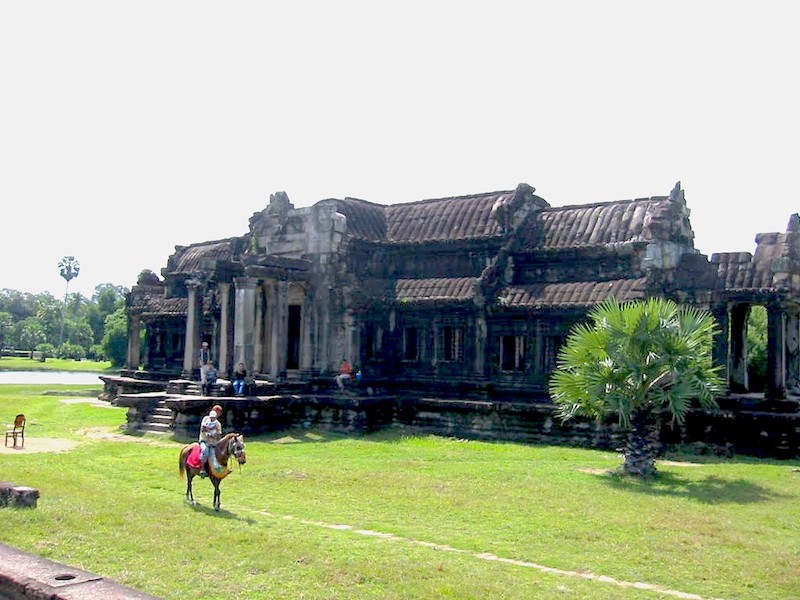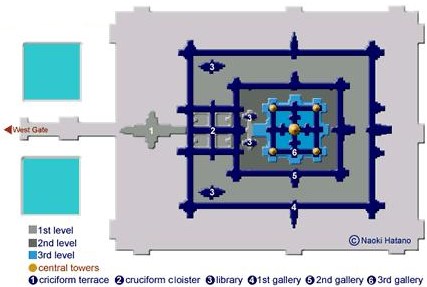
Angkor Wat Temple

 Angkor Wat is
the
centerpiece of the Siem Reap temple complex, and is the
largest
religious shrine in the world. It contains more masonry than
the Great
Pyramid at Giza, a fact made all the more impressive by the
fact that
it is intricately carved stone rather than the massive stone
blocks of
the pyramid. Built in the first half of the twelfth century by
Suryavarman II (the 18th Cambodian King), Angkor Wat was
constructed in
about thirty five years. Surayavarman II was an ambitious king
in terms
of both territorial conquest and his legacy. This 1 km by 800
meter
(3,330 by 2,600 feet) temple was dedicated to the Hindu God
Vishnu,
with whom it is believed that Surayvarman merged with upon
death. A
deity incarnate, Angkor Wat was apparently designed as a
funery temple;
it faces west, catching the dying rays of the sun, symbolic of
the end
of man's earthly life. The photo above captures the western
main
entrance to Angkor Wat in the fading light of the
Angkor Wat is
the
centerpiece of the Siem Reap temple complex, and is the
largest
religious shrine in the world. It contains more masonry than
the Great
Pyramid at Giza, a fact made all the more impressive by the
fact that
it is intricately carved stone rather than the massive stone
blocks of
the pyramid. Built in the first half of the twelfth century by
Suryavarman II (the 18th Cambodian King), Angkor Wat was
constructed in
about thirty five years. Surayavarman II was an ambitious king
in terms
of both territorial conquest and his legacy. This 1 km by 800
meter
(3,330 by 2,600 feet) temple was dedicated to the Hindu God
Vishnu,
with whom it is believed that Surayvarman merged with upon
death. A
deity incarnate, Angkor Wat was apparently designed as a
funery temple;
it faces west, catching the dying rays of the sun, symbolic of
the end
of man's earthly life. The photo above captures the western
main
entrance to Angkor Wat in the fading light of the

 afternoon,
when
the composition of the stone seems to turn from grey to a rosy
brown. The full magnificence of Angkor Wat is only hinted at
when one
crosses the 200 meter moat, as three of its towers and the
main outline
of the temple remain obscured behind its outer walls. Once one
passes
through the main gate, Angor Wat opens up into a grand
courtyard, shown
in the photo at the upper right and left. The photo to the
left shows
three of the five towers, which represent the five peaks of
Mount Meru,
the home of the Hindu gods. It is accessed via a long walkway;
the
photo at the upper right shows one of the libraries located
midway
between the outer walls and the temple. The photo at lower
left shows a
close-up of the library. Access to the temple is gained via a
raised
cruciform platform, shown in the photo at bottom right.
afternoon,
when
the composition of the stone seems to turn from grey to a rosy
brown. The full magnificence of Angkor Wat is only hinted at
when one
crosses the 200 meter moat, as three of its towers and the
main outline
of the temple remain obscured behind its outer walls. Once one
passes
through the main gate, Angor Wat opens up into a grand
courtyard, shown
in the photo at the upper right and left. The photo to the
left shows
three of the five towers, which represent the five peaks of
Mount Meru,
the home of the Hindu gods. It is accessed via a long walkway;
the
photo at the upper right shows one of the libraries located
midway
between the outer walls and the temple. The photo at lower
left shows a
close-up of the library. Access to the temple is gained via a
raised
cruciform platform, shown in the photo at bottom right.
Angkor Wat is a very elaborate temple, built on three levels, and it is very difficult to envision from written descriptions. This tour takes you through the temple in the fashion you are most likely to encounter it on a tour. Let us begin with a general description of the complex Vertically speaking, Angkor Wat is built upon three levels, with the third level leading to its famous five peaks. When viewed architecturally and functionally, the complex can be divided into two areas:
The
outer courtyard: extending from the moat to the wall
complex shown
above, including the cruciform platform (Figure 1
in the both
the diagram above and below)

The inner temple complex: the main area enclosed by the complex walls, divided into two squares:
a cruciform cloister and libraries near the western entrance on the second level
a larger cruciform terrace on the third level that includes offices and the temple itself.
The numbers on the tour below correspond to the path most visitors take when visiting Angkor Wat. Tours begin by turning right at the cruciform platform, following the terrace on level one. Angkor Wat boasts the world's largest bas-relief, extending all the way around the temple, protected by a covered walkway. Upon returning to the entrance, visitors can ascend the stairs to the cruciform cloisters on the second terrace. Stairs from the cloisters lead to the third terrace and the cruciform terrace that contains the main temple.
Architectural Tour of Angkor Wat
Instructions:
Place the
cursor on a number and click to view that feature in a new
window.
Click on
"Close" to shut that window and return to the Red Fort
diagram. [Hint:
be certain not to drag the mouse over another number, or it
will open
that window instead] If this doesn't work (or
negotiating between
the numbers is too annoying), click on the links in the box
below. If
you are using the map, be sure ad-blocker is turned off for
this site.
On mobile devices, the "Close" button may not work. In that
case, use
your browser's "Back" button.

|
10. Battle
of
Lanka |
14. Bakan
Gallery |
||
|
15. Central
Tower |
|||
| 4. Suryavarman
II
Gallery |
8. Krishna
Gallery |
12. Third
Level
Terrace and Libraries |
16. Buddha
Shrine |
Angkor Wat
Redux:
In 2008 we returned to Angkor Wat and were able to assemble a much more comprehensive tour which you can view (along with Angkor Thom) on our VR Angkor Wat Tour